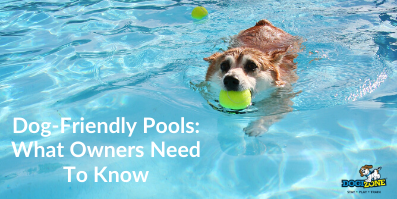Dog-Friendly Pools: What Owners Need To Know
Most dogs love to cool off with a swim, and they are natural swimmers. But dog-friendly pools are important to consider.
Keeping your dog safe in the pool does take some training and advanced preparation. Just like children, dogs should never be allowed in a pool, or even a lake, without constant supervision. Unfortunately, dogs can and do drown every summer. These types of tragedies can be prevented with proper pool safety and supervision by owners.
In and Out of the Dog-Friendly Pools
Dogs are often fearless about jumping into the pool. With their body shape and their flat jump, they are not at risk of injury from hitting the bottom. Dogs can go completely under the water during this jump, and it may create a sense of panic in some pets.
Teaching your dog to use steps in the pool to get into the water can prevent this type of problem. It will be essential to work with your dog to learn to go to the step area to get out of the pool. Dogs will have a great deal of difficulty getting out of the pool on the sides. They will be able to place their paws on the edge, but many dogs do not have the ability to get out on the side. As they become stressed with not being able to get out they panic, increasing the risk of drowning.
If your pool does not have steps built into the design, consider attaching a set of pet stairs to the end of the pool. Ramps can also be used for older dogs to allow easy exit and entry. Train and reward the dog for using the steps or the ramp. Do not move the device to ensure the dog always knows where to swim to leave the pool.
Teach Swimming Lessons
While most dogs can swim, they need assistance and help when they cannot gradually move out into deeper water. By using a pet floatation vest or supporting the dog’s chest and body, he or she can learn to use both their front and hind legs to move through the water.
Only allow the dog in the pool on his or her own if he or she is an accomplished swimmer. Older dogs or obese pets, or those that are fearful of the water, should never be left in a pool without someone in the pool for immediate help.
Pool Chemicals and Products
Correct use of pool chemicals such as chlorine or water shock products should be safe for dogs when used in the right concentration. The key to preventing skin irritation and damage to the coat is to be sure to completely rinse the dog off after each swim. Make this a routine and a positive experience for the dog.
Be sure to store all pool equipment and chemicals in a secure location. This prevents access by kids and pets, reducing any risk of exposure. Keep the pool area secured with a fence to prevent the dog from drinking from the pool, which can cause stomach upsets. Having a fence also prevents dogs from falling into the pool, and pool fences are often required by law.

